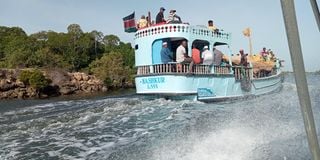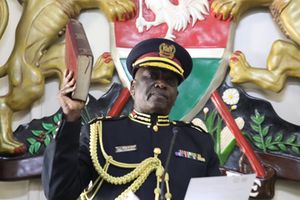How we use the moon to manoeuvre around Indian Ocean

A boat full of passengers at the Indian Ocean's Mkanda Channel in Lamu County. It is is one of the most dangerous top navigate.
For centuries, Lamu boat operators’ rich knowledge of the Indian Ocean has always set them apart from other coxswains out there.
In this part of the world, boat steering takes more than just education and papers and the secret to surviving the trade is mastering the behaviour of the sea.
In fact, the most polished coxswains in Lamu never actually set foot in class but their skills are highly sought after by professionals who studied coxswaining at maritime colleges across the country and the world.
Nation.Africa sought to understand why Lamu coxswains continue to prosper in the industry and even outsmart educated individuals who have flocked to the trade in recent years.
The Lamu archipelago has over 5,000 boat operators.
Nearly half of them have not undergone formal education on boat steering.
Mr Hassan Awadh, the chairperson of the Lamu Boat Operators Association, says Lamu coxswains would continue to shine in the industry because of their unique and natural skills acquired outside formal classes.
Mr Awadh highlighted some crucial factors that identify a Lamu coxswain as qualified.
One is having a wealth of knowledge about sea channels.
The Mlango wa Tanu in Mkokoni, Mlango wa Alii and Ngaya in Kiwayu, and Mlango wa Bomani in Kiunga, all in Lamu East sub-county are among several dangerous channels in the Indian Ocean where many boat accidents have happened, leading to deaths and loss of cargo.
Other equally dangerous channels include Mkanda, Manda Bruno, Shella, Mlango wa Kipungani, and Zinyika in Lamu West.
They are located in the deepest parts of the ocean and are characterised by rough tides and deadly waves at all times.
These channels have been branded death traps as they are complicated to manoeuvre even by the most experienced divers and boat operators in the region.
“As a coxswain here, you need to have information about these channels and their behaviour that varies depending on the seasons. Such information is crucial as it enables you to understand the safe or dangerous times for travelling. This will prevent you from getting into accidents and dying at sea,” Mr Awadh says.
Another key factor is knowledge about ocean tides and waves.
Mr Awadh says Lamu coxswains, having acquired their skills through apprenticeship, can read the behaviour of the moon that directly influences ocean tides.
He says most of those riding boats in Lamu today inherited the skills from their ancestors, who used ancient methods to determine safe travel dates, just by observing the moon's movement.

A cargo boat in the Indian Ocean's Mkanda channel in Lamu County.
“As sailors, we all know that tides come twice a day, vary according to the moon, and depend on where you are sailing,” Mr Awadh says.
“This knowledge is critically important to the successful completion of your voyage. If you miscalculate the moon’s behaviour, then you’re likely to blunder. You’ll be caught up with either high or low tides at sea that definitely make it impossible for you to travel.”
Running aground is also a lot more common than one might think in water transport.
Mr Awadh says such a situation can be in varying degrees of severity depending on where a person is boating.
“On soft mud or sand bottom, it’s usually no big deal, but in a rocky harbour, hitting bottom can do some serious damage. So the solution here is for you as a coxswain to always be aware of where you are and what the local underwater hazards may be,” he says.
“And when in doubt, slowing down is a good idea. But this knowledge isn’t understood by all except Lamu coxswains considered qualified.”
Said Mohamed, a coxswain who has been in the industry for 20 years, says that though he has no formal education in coxswaining, many maritime undergraduate students coming to the county for industrial attachments have gone through his hands.
“My grandfather taught me boat steering when I was five years old. I am happy that many maritime students coming here for attachment are always directed to me. Many passengers also opt to travel in my boat because they like my mode of operation,” says Mr Mohamed.
Kassim Musa, a shipper who ferries miraa via speedboat daily to Mkokoni, Ndau, Kiunga, and Ishakani, says coxswain must equip themselves with knowledge about the behaviour of ocean tides or they would not reach some of their intended destinations.
“If you go to a place like Ndau or Mkokoni during low tides, you won’t access the islands. You will be forced to wait for hours until the tides are high before taking your boat to the shores to offload your cargo. This industry needs one to be more practical rather than theoretical,” explains Mr Musa.
And Abdallah Twalib, 48, notes that acquiring marine-related skills is an added advantage.
Mr Twalib, a boater for 35 years, advised institutions offering maritime courses to embrace local knowledge.
“Many government employees deployed in a place like Lamu to work in the maritime industry end up frustrated. They don’t know what to do. Some even quit their job. Others have to work under us for some time before mastering the art of boat operation,” he says.
Another crucial factor that sets Lamu coxswains apart is that they do not have to rely on modern marine navigation instruments.
A coxswain will normally require a compass to determine which direction they are supposed to head.
“We’re naturally aware of the sea direction and how to locate and get home, whether it is daytime or very late at night and regardless of whether we have navigation instruments or not. We’re taught to plot direction at sea at a very early age,” says Abdulkarim Badawy.
Lamu coxswains appealed to the government to prioritise them when they are hiring maritime staff instead of recruiting from outside the region now that the Lamu port is operating.





